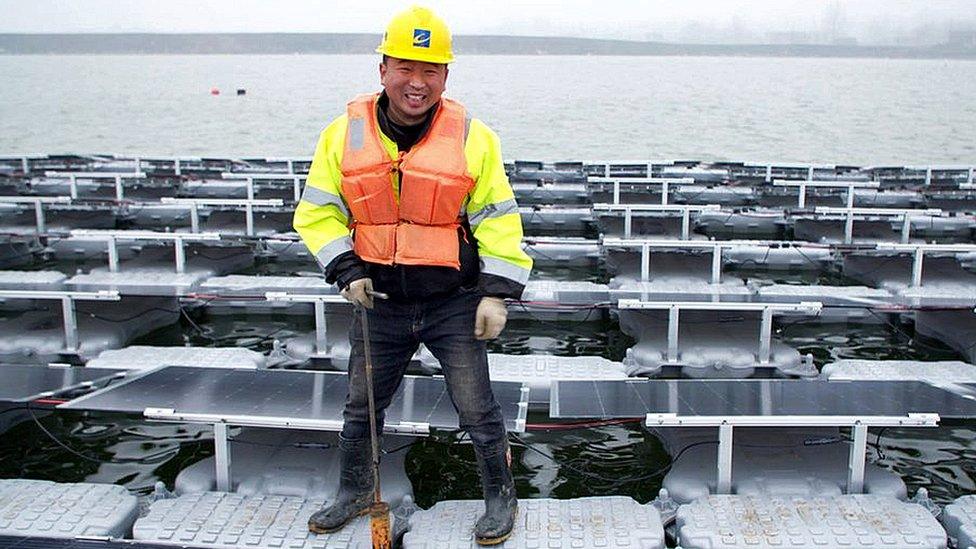Meet the ex-miners who are now walking on water
- Published

Ex-miner Wu Wenhui has retrained as a solar panel assembler at Sungrow
Wenhui giggles as he shares some banter with his friend Xiaosi. They've got used to walking on water.
It's a fresh, misty morning. They move between the gently rocking solar panels fixing them to pontoon floats.
"It's about the air. I can breathe more easily," says Wenhui
A few years ago, his life was quite different - he worked 800 metres beneath this lake as a coal miner. Now one firm, Sungrow, has turned it into the world's biggest floating solar farm.
"I am so much happier," says Wenhui.
Health benefits
"When we worked in the mine, it was dark and the conditions were extremely bad, which was harmful to your health."
"Every day my mother would pray for me," nods Xiaosi.

Sungrow opened the world's biggest floating solar farm in Anhui province in 2017
Each year thousands of miners die from lung disease. Wenhui and Xiaosi have lost friends to one particularly nasty form of silicosis - known as black lung.
" The most important thing is that this industry is really good for our health. We all have parents and children. We just can't afford to get sick."
Pay and skills
Wenhui says he retrained as a solar panel assembler at Guqiao with Sungrow nine months ago.
"Working in the mine, we could only make… a bit more than 4,000 yuan ($630: £450)."
Whereas now he earns more than 5,000 yuan: "That's nearly 20,000 yuan a year, which is a huge sum of money for our families."

The Anhui solar is on the site of villages that collapsed and flooded following a coal mine disaster
Watching the sun rise over, the world's biggest floating solar farm, near Anhui, with flocks of geese gliding between the reeds it is hard to believe the project was only made possible by tragedy.
Only a few remaining derelict houses, submerged by the water hint at the villages that used to stand here.
Ten years ago the coal mine below collapsed destroying homes and livelihoods in the area. Over time the sunken village filled with rain to become a vast lake.
There are dozens of flooded coal mines across China, and Sungrow hopes to turn these disasters into opportunity.
World record
Sungrow's Guqiao solar farm, will be four times bigger than its current record-holder Anhui when it is finished.
"This 150 megawatt programme can generate 160 million kilowatt hours of electricity a year says Guqiao project manager Shi Xianbin.
In China, that is enough electricity to power 15,000 homes.
The project will also generate 20 million yuan for the local economy and provide skilled jobs for local people.
Coal costs
China is the world's biggest polluter. It produces more carbon emissions than any other nation and that is largely due to its reliance on coal.
According to a report by the World Health Organisation, more than a million deaths in 2016 in China resulted from airborne pollution.
Much these harmful particulates are the by-products of burning coal.
As a result the country has reduced its consumption of coal steadily over the last few years and invested heavily in solar and other renewable sources of energy.

Solar panel assembler Wu Wenhui hopes his son will opt for a career in a clean industry like solar power rather than coal mining
Sungrow's chief engineer sums up growing sentiment across China: "We people of this generation are responsible for preserving our clean blue sky and white clouds for the future of our children."
Future generations
After a day out on the water, Wenhui heads back to the dormitory he shares with about a dozen colleagues.
Wenhui's family is based in the region's capital city Hefei. It is a common existence for workers on big projects like Guqiao.
After a communal meal he makes a video call to his son and asks him how his exams went at school.
"I think the future of this industry is bright, even though I am still just an assembler now," says Wenhui.
"As for my kid, I hope that he can do a job, which is good for his health, can bring him happiness and a steady income."
Part of our series Taking the Temperature, which focuses on the battle against climate change and the people and ideas making a difference.
This BBC series was produced with funding from the Skoll Foundation
- Published20 April 2018
